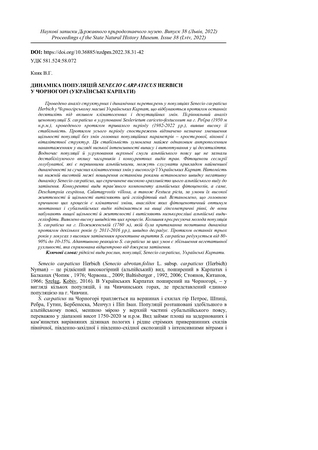Kyyak V.H.
Population dynamics of Senecio carpaticus Herbich in the Chornohora (Ukrainian Carpathians) // Proc. of the State Nat. Hist. Mus. - Lviv, 2022. - 38. - P. 31-42 DOI: https://doi.org/10.36885/nzdpm.2021.38.31-42 Key words: rare plant species, populations, Senecio carpaticus, Ukrainian Carpathians An analysis of the structural and dynamic transformations in the populations of Senecio сarpaticus Herbich in the Chornohora range (the Ukrainian Carpathians), which have occurred during the last decades under the influence of climatogenic and demutational changes, was conducted. A comparative analysis of the population of S. sarpaticus in the Seslerietum cariceto-festucosum grouping on Rebra mountain (1950 m. above sea level), which had been conducted over a long period (1982-2022), revealed its high stability. During the entire period of observations, a slight decrease in the population density was noted without any changes among the main population parameters - spatial, age and vitality structures. This stability is caused by almost the same anthropogenic load in the form of low intensity of grazing and trampling during these decades. At the same time, the populations and groups of the upper zone of the alpine zone have not experienced the destabilizing influence of shrubs and competitive plant species yet. Phytocenoses of Sesleria coerulans, which are primary alpine, can serve as an example of the least dynamics under modern climate changes in the highlands of the Ukrainian Carpathians. On the other hand, the rapid negative dynamics of Senecio сarpaticus has been detected at the lower altitudinal limit of spreading in recent years, which is caused by the high vulnerability of this alpine species to shading. Competitive species of the grass of alpine phytocenoses, to be specific, Deschampsia cespitosa, Calamagrostis villosa, as well as Festuca picta, on the condition of their high vitality and density displace this heliophytic species. It was established that the main cause of these processes is climate changes, as a result of which the phytocenotic optimum of montane and subalpine species rises to higher hypsometric levels, where they acquire higher density as well as vitality and displace shorter alpine heliophyte species. The high speed of these processes was revealed. The population of Senecio carpaticus, which used to be progressive and young on Pozhyzhevska mountain (1760 m) and was characterized by positive dynamics for several years (in 2011-2016), is rapidly degrading. During the last three years the projective cover of S. carpaticus in locuses with high shading has been reducing from 80-90% to 10-15%. The adaptive response of S. carpaticus under these conditions is an increase in vegetative mobility, which is directed centrifugally from the source of shading.
Population dynamics of Senecio carpaticus Herbich in the Chornohora (Ukrainian Carpathians) // Proc. of the State Nat. Hist. Mus. - Lviv, 2022. - 38. - P. 31-42 DOI: https://doi.org/10.36885/nzdpm.2021.38.31-42 Key words: rare plant species, populations, Senecio carpaticus, Ukrainian Carpathians An analysis of the structural and dynamic transformations in the populations of Senecio сarpaticus Herbich in the Chornohora range (the Ukrainian Carpathians), which have occurred during the last decades under the influence of climatogenic and demutational changes, was conducted. A comparative analysis of the population of S. sarpaticus in the Seslerietum cariceto-festucosum grouping on Rebra mountain (1950 m. above sea level), which had been conducted over a long period (1982-2022), revealed its high stability. During the entire period of observations, a slight decrease in the population density was noted without any changes among the main population parameters - spatial, age and vitality structures. This stability is caused by almost the same anthropogenic load in the form of low intensity of grazing and trampling during these decades. At the same time, the populations and groups of the upper zone of the alpine zone have not experienced the destabilizing influence of shrubs and competitive plant species yet. Phytocenoses of Sesleria coerulans, which are primary alpine, can serve as an example of the least dynamics under modern climate changes in the highlands of the Ukrainian Carpathians. On the other hand, the rapid negative dynamics of Senecio сarpaticus has been detected at the lower altitudinal limit of spreading in recent years, which is caused by the high vulnerability of this alpine species to shading. Competitive species of the grass of alpine phytocenoses, to be specific, Deschampsia cespitosa, Calamagrostis villosa, as well as Festuca picta, on the condition of their high vitality and density displace this heliophytic species. It was established that the main cause of these processes is climate changes, as a result of which the phytocenotic optimum of montane and subalpine species rises to higher hypsometric levels, where they acquire higher density as well as vitality and displace shorter alpine heliophyte species. The high speed of these processes was revealed. The population of Senecio carpaticus, which used to be progressive and young on Pozhyzhevska mountain (1760 m) and was characterized by positive dynamics for several years (in 2011-2016), is rapidly degrading. During the last three years the projective cover of S. carpaticus in locuses with high shading has been reducing from 80-90% to 10-15%. The adaptive response of S. carpaticus under these conditions is an increase in vegetative mobility, which is directed centrifugally from the source of shading.
References


